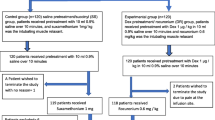Abstract
We used target-controlled infusion (TCI) of dexmedetomidine (DEX) for awake intubation under sedation in 5 patients who had a risk of pulmonary aspiration or difficult airway. Dexmedetomidine level was escalated stepwise until the patients developed tolerance to laryngoscopy. The target DEX concentrations at the time of intubation were 2.10–5.95 ng/ml and were higher than those clinically used for sedation in the intensive care unit (ICU). Chin lift was applied in 1 case, and therefore no assisted ventilation was required and pulse oxygen saturation was maintained at >98% throughout the procedure. Simple pharmacological interventions for blood pressure changes induced by increased target plasma DEX concentrations were needed in 4 cases. However, hemodynamics was stable, and no cardiovascular drug was needed after tracheal intubation. Conditions at laryngoscopy were excellent in all cases, and conditions at tracheal intubation were good except in 1 case. Reflex to intubation was preserved in all cases, and coughing was observed in all cases. The patients had no memory of discomfort and/or intubation. Although further investigations are needed, this method may be useful for awake intubation under sedation.

Similar content being viewed by others
References
Ebert TJ, Hall JE, Barney JA, Uhrich TD, Colinco MD. The effects of increasing plasma concentrations of dexmedetomidine in humans. Anesthesiology. 2000;93:382–94.
Ramsay MA, Savege TM, Simpson BR, Goodwin R. Controlled sedation with alphaxalone–alphadolone. Br Med J. 1974;2:656–9.
Grant SA, Breslin DS, MacLeod DB, Gleason D, Martin G. Dexmedetomidine infusion for sedation during fiberoptic intubation: a report of three cases. J Clin Anesth. 2004;16:124–6.
Dyck JB, Maze M, Haack C, Azarnoff DL, Vuorilehto L, Shafer SL. Computer-controlled infusion of intravenous dexmedetomidine hydrochloride in adult human volunteers. Anesthesiology. 1993;78:821–8.
Naguib M, Samarkandi AH, El-Din ME, Abdullah K, Khaled M, Alharby SW. The dose of succinylcholine required for excellent endotracheal intubating conditions. Anesth Analg. 2006;102:151–5.
Kamibayashi T, Maze M. Clinical uses of alpha2—adrenergic agonists. Anesthesiology. 2000;93:1345–9.
Ramsay MA, Luterman DL. Dexmedetomidine as a total intravenous anesthetic agent. Anesthesiology. 2004;101:787–90.
Aantaa R. Assessment of the sedative effects of dexmedetomidine, an alpha 2-adrenoceptor agonist, with analysis of saccadic eye movements. Pharmacol Toxicol. 1991;68:394–8.
Acknowledgments
Support was provided solely from institutional and/or departmental sources.
Author information
Authors and Affiliations
Corresponding author
About this article
Cite this article
Kunisawa, T., Nagashima, M., Hanada, S. et al. Awake intubation under sedation using target-controlled infusion of dexmedetomidine: five case reports. J Anesth 24, 789–792 (2010). https://doi.org/10.1007/s00540-010-0980-8
Received:
Accepted:
Published:
Issue Date:
DOI: https://doi.org/10.1007/s00540-010-0980-8




